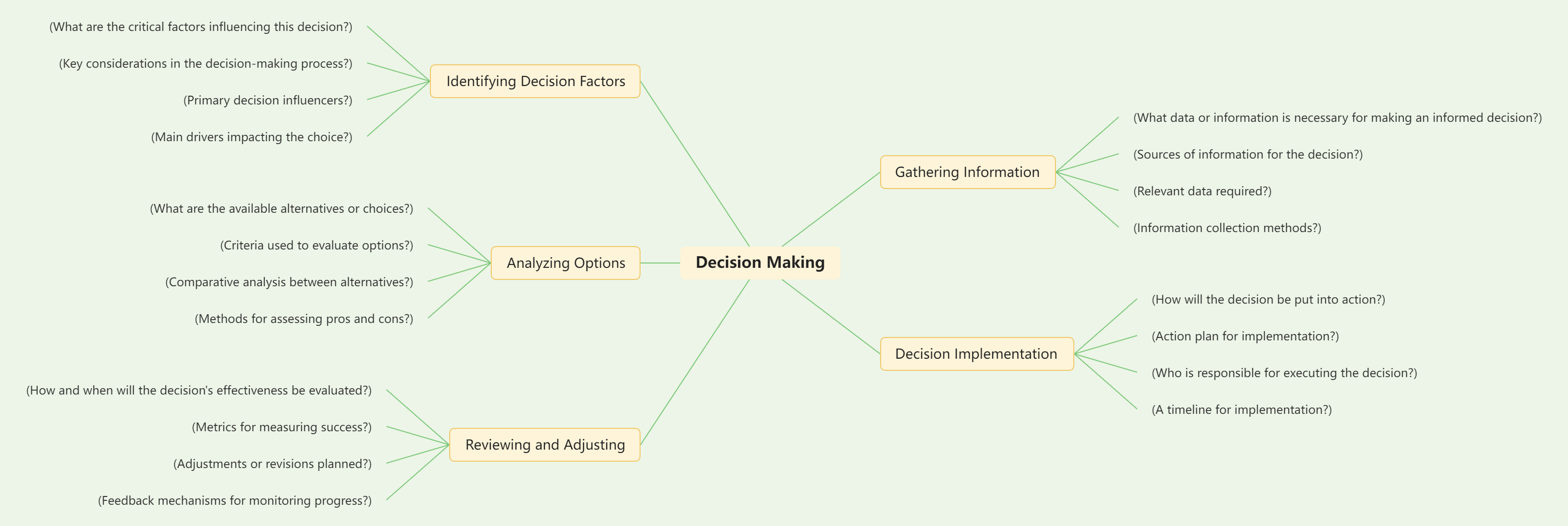
The 5 Stages of Decision Making
The mind map on Decision Making comprises five interconnected parts, providing a structured approach to navigating the complexities of decision-making processes. It initiates with “Identifying Decision Factors,” encouraging a thorough exploration of critical elements influencing the decision at hand. By posing questions about key considerations, influencers, and drivers, individuals gain clarity on the factors shaping their choices. The subsequent stage, “Gathering Information,” underscores the importance of a well-informed decision, prompting users to identify necessary data, relevant sources, and methods for information collection. Moving forward, “Analyzing Options” delves into the realm of alternatives and choices, emphasizing the need for criteria-based evaluations and comparative analyses to facilitate a comprehensive decision-making framework.
As decisions transition from analysis to action, the mind map introduces “Decision Implementation,” addressing the crucial aspect of executing chosen options. It outlines an action plan, assigns responsibilities, and sets a timeline for effective implementation. Finally, the mind map concludes with “Reviewing and Adjusting,” stressing the iterative nature of decision-making. By highlighting the need for evaluating decisions, establishing success metrics, planning adjustments, and incorporating feedback mechanisms, the mind map guides individuals through a continuous improvement cycle. In essence, this mind map acts as a roadmap for thoughtful, informed, and dynamic decision-making, ensuring that choices are well-grounded, effectively implemented, and subject to ongoing scrutiny for continuous enhancement.
Decoding Decision-Making with Mind Maps
The mind map on Decision Making serves as an invaluable tool in enhancing the clarity, effectiveness, and efficiency of the decision-making process. By breaking down the complex task of decision-making into identifiable components, the mind map provides a structured framework that guides individuals through each stage of the process. It acts as a visual aid, fostering a comprehensive understanding of the critical factors, information sources, and available alternatives. This visual representation not only helps in organizing thoughts but also facilitates better communication and collaboration within teams. Additionally, the mind map’s emphasis on decision implementation and ongoing review and adjustment ensures that decisions are not only well-informed but also adaptive to changing circumstances. Overall, the mind map acts as a strategic guide, empowering individuals and teams to make sound decisions, implement them effectively, and continually refine their approach for optimal outcomes.
Unleashing Potential with Visual Paradigm Smart Board
Creating a decision-making mind map becomes an intuitive and seamless process with Visual Paradigm Smart Board. This versatile tool offers an array of features to enhance your decision-making journey. Starting with an easy-to-use interface, users can edit the content, facilitating the mapping of decision factors, information sources, options, and implementation plans. The customizable templates provide a solid foundation, allowing users to adapt the mind map to their specific decision context. The tool’s flexibility extends to various devices, enabling users to start, edit, or review their decision-making mind maps from anywhere. Overall, Visual Paradigm Smart Board streamlines the creation of decision-making mind maps, fostering collaboration, clarity, and informed choices.